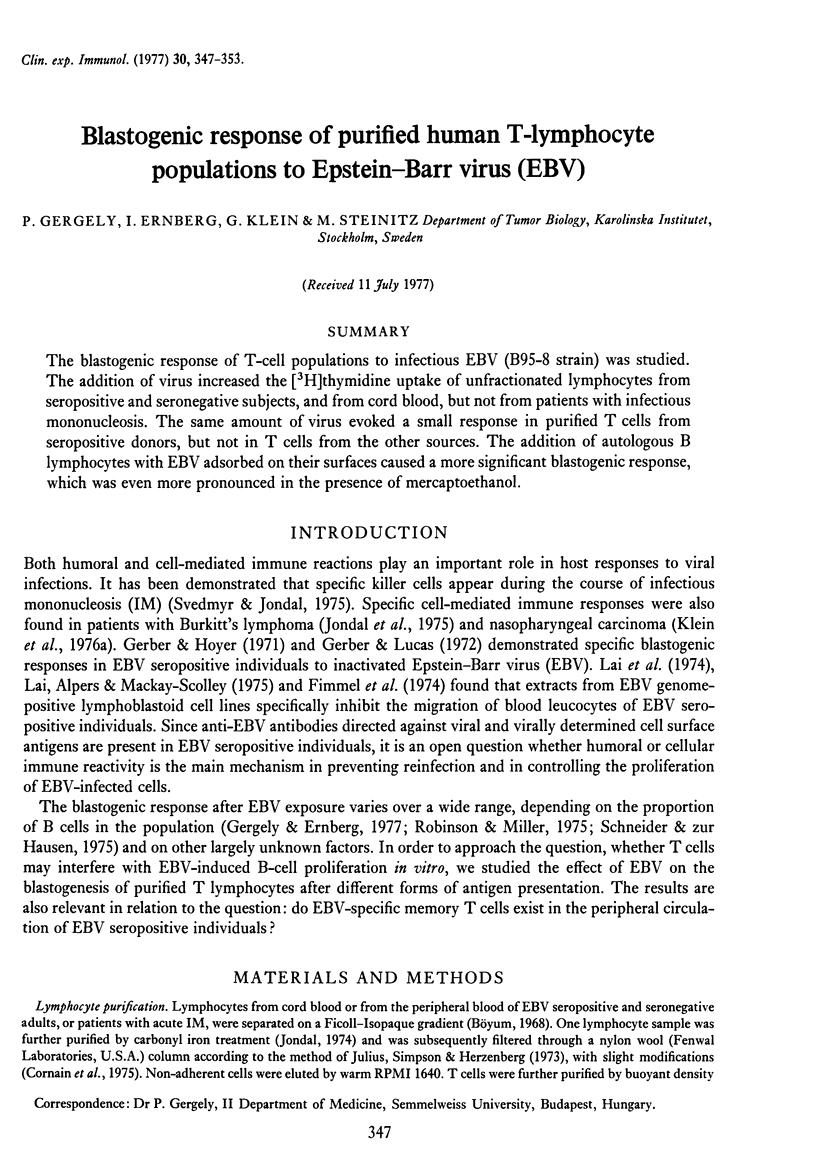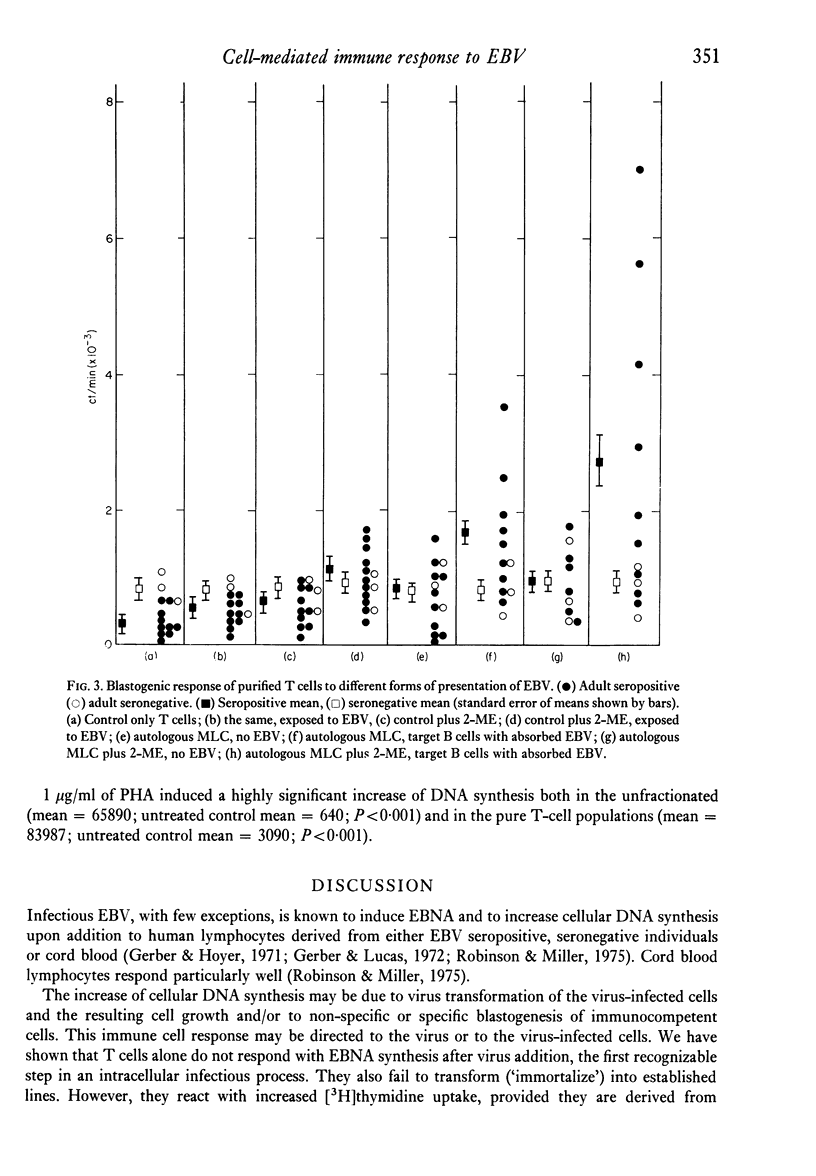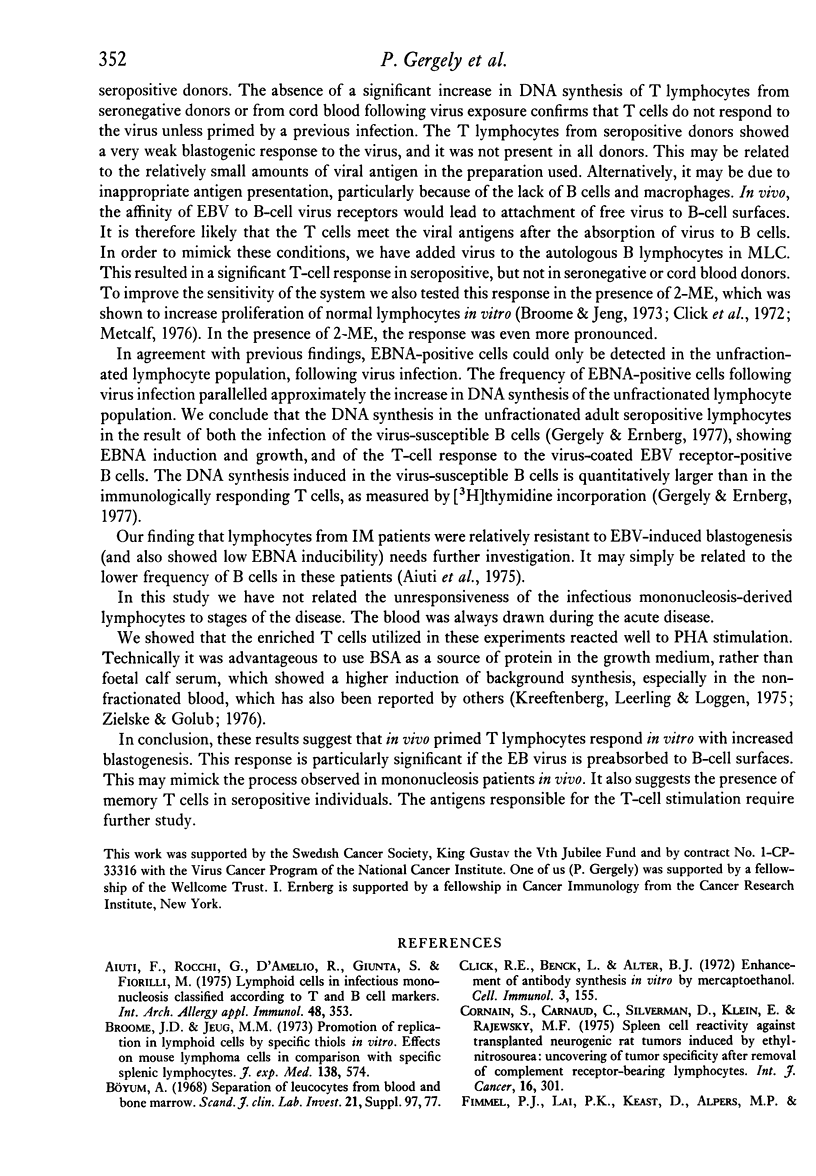Abstract
The blastogenic response of T-cell populations to infectious EBV (B95-8 strain) was studied. The addition of virus increased the [3H]thymidine uptake of unfractionated lymphocytes from seropositive and seronegative subjects, and from cord blood, but not from patients with infectious mononucleosis. The same amount of virus evoked a small response in purified T cells from seropositive donors, but not in T cells from the other sources. The addition of autologous B lymphocytes with EBV adsorbed on their surfaces caused a more significant blastogenic response, which was even more pronounced in the presence of mercaptoethanol.
Full text
PDF






Selected References
These references are in PubMed. This may not be the complete list of references from this article.
- Aiuti F., Rocchi G., D'Amelio R., Giunta S., Fiorilli M. Lymphoid cells in infectious mononucleosis classified according to T and B cell markers. Int Arch Allergy Appl Immunol. 1975;48(3):353–363. doi: 10.1159/000231320. [DOI] [PubMed] [Google Scholar]
- Broome J. D., Jeng M. W. Promotion of replication in lymphoid cells by specific thiols and disulfides in vitro. Effects on mouse lymphoma cells in comparison with splenic lymphocytes. J Exp Med. 1973 Sep 1;138(3):574–592. doi: 10.1084/jem.138.3.574. [DOI] [PMC free article] [PubMed] [Google Scholar]
- Cornain S., Carnaud C., Silverman D., Klein E., Rajewsky M. F. Spleen-cell reactivity against transplanted neurogenic rat tumors induced by ethylnitrosourea: uncovering of tumor specificity after removal of complement-receptor-bearing lymphocytes. Int J Cancer. 1975 Aug 15;16(2):301–311. doi: 10.1002/ijc.2910160213. [DOI] [PubMed] [Google Scholar]
- Fimmel P. J., Lai P. K., Keast D., Alpers M. P., Mackay-Scollay E. M. In vitro cellular immunity to Epstein-Barr virus in normal human subjects. Int J Cancer. 1974 May 15;13(5):599–605. doi: 10.1002/ijc.2910130504. [DOI] [PubMed] [Google Scholar]
- Gerber P., Hoyer B. H. Induction of cellular DNA synthesis in human leukocytes by Epstein-Barr virus. Nature. 1971 May 7;231(5297):46–47. doi: 10.1038/231046a0. [DOI] [PubMed] [Google Scholar]
- Gerber P., Lucas S. J. In vitro stimulation of human lymphocytes by Epstein-Barr virus. Cell Immunol. 1972 Oct;5(2):318–324. doi: 10.1016/0008-8749(72)90057-3. [DOI] [PubMed] [Google Scholar]
- Gergely P., Ernberg I. Blastogenic response and EBNA induction in human lymphocytes by Epstein-Barr virus only requires B cells but not macrophages. Cancer Lett. 1977 Mar;2(4-5):217–220. doi: 10.1016/s0304-3835(77)80024-4. [DOI] [PubMed] [Google Scholar]
- Gergely P., Vanky F., Klein E. Spontaneous and PHA-induced rosetting of human blood, tonsil lymphocytes and MLC blasts with sheep, human and horse erythrocytes. Clin Exp Immunol. 1976 Jul;25(1):23–27. [PMC free article] [PubMed] [Google Scholar]
- Henle G., Henle W. Immunofluorescence in cells derived from Burkitt's lymphoma. J Bacteriol. 1966 Mar;91(3):1248–1256. doi: 10.1128/jb.91.3.1248-1256.1966. [DOI] [PMC free article] [PubMed] [Google Scholar]
- Henle G., Henle W., Klein G. Demonstration of two distinct components in the early antigen complex of Epstein-Barr virus-infected cells. Int J Cancer. 1971 Sep 15;8(2):272–282. doi: 10.1002/ijc.2910080212. [DOI] [PubMed] [Google Scholar]
- Henle W., Guerra A., Henle G. False negative and prozone reactions in tests for antibodies to Epstein-Barr virus-associated nuclear antigen. Int J Cancer. 1974 Jun 15;13(6):751–754. doi: 10.1002/ijc.2910130603. [DOI] [PubMed] [Google Scholar]
- Jondal M., Holm G., Wigzell H. Surface markers on human T and B lymphocytes. I. A large population of lymphocytes forming nonimmune rosettes with sheep red blood cells. J Exp Med. 1972 Aug 1;136(2):207–215. doi: 10.1084/jem.136.2.207. [DOI] [PMC free article] [PubMed] [Google Scholar]
- Jondal M. Surface markers on human B and T lymphocytes. IV. Distribution of surface markers on resting and blast-transformed lymphocytes. Scand J Immunol. 1974;3(6):739–747. doi: 10.1111/j.1365-3083.1974.tb01309.x. [DOI] [PubMed] [Google Scholar]
- Jondal M., Svedmyr E., Klein E., Singh S. Killer T cells in a Burkitt's lymphoma biopsy. Nature. 1975 May 29;255(5507):405–407. doi: 10.1038/255405a0. [DOI] [PubMed] [Google Scholar]
- Julius M. H., Simpson E., Herzenberg L. A. A rapid method for the isolation of functional thymus-derived murine lymphocytes. Eur J Immunol. 1973 Oct;3(10):645–649. doi: 10.1002/eji.1830031011. [DOI] [PubMed] [Google Scholar]
- Klein E., Becker S., Svedmyr E., Jondal M., Vánky F. Tumor infiltrating lymphocytes. Ann N Y Acad Sci. 1976;276:207–216. doi: 10.1111/j.1749-6632.1976.tb41647.x. [DOI] [PubMed] [Google Scholar]
- Klein G., Svedmyr E., Jondal M., Persson P. O. EBV-determined nuclear antigen (EBNA)-positive cells in the peripheral blood of infectious mononucleosis patients. Int J Cancer. 1976 Jan 15;17(1):21–26. doi: 10.1002/ijc.2910170105. [DOI] [PubMed] [Google Scholar]
- Kreeftenberg J. G., Leerling M. F., Loggen H. G. B- and T-cell markers on human lymphoblasts after stimulation with mitogen or antigens. Clin Exp Immunol. 1975 Oct;22(1):121–125. [PMC free article] [PubMed] [Google Scholar]
- Kuntz M. M., Innes J. B., Weksler M. E. Lymphocyte transformation induced by autologous cells. IV. Human T-lymphocyte proliferation induced by autologous or allogeneic non-T lymphocytes. J Exp Med. 1976 May 1;143(5):1042–1054. doi: 10.1084/jem.143.5.1042. [DOI] [PMC free article] [PubMed] [Google Scholar]
- Lai P. K., Alpers M. P., Mackay Scollay E. M. In vitro evaluation of cell-mediated immunity to Epstein-Barr herpesvirus by cell migration inhibition tests. J Natl Cancer Inst. 1975 Dec;55(6):1319–1322. doi: 10.1093/jnci/55.6.1319. [DOI] [PubMed] [Google Scholar]
- Lai P. K., Mackay-Scollay E. M., Fimmel P. J., Alpers M. P., Keast D. Cell-mediated immunity to Epstein-Barr virus and a blocking factor in patients with infectious mononucleosis. Nature. 1974 Dec 13;252(5484):608–610. doi: 10.1038/252608a0. [DOI] [PubMed] [Google Scholar]
- Metcalf D. Role of mercaptoethanol and endotoxin in stimulating B lymphocyte colony formation in vitro. J Immunol. 1976 Mar;116(3):635–638. [PubMed] [Google Scholar]
- Miller G., Lipman M. Release of infectious Epstein-Barr virus by transformed marmoset leukocytes. Proc Natl Acad Sci U S A. 1973 Jan;70(1):190–194. doi: 10.1073/pnas.70.1.190. [DOI] [PMC free article] [PubMed] [Google Scholar]
- Opelz G., Kiuchi M., Takasugi M., Terasaki P. I. Autologous stimulation of human lymphocyte subpopulation. J Exp Med. 1975 Nov 1;142(5):1327–1333. doi: 10.1084/jem.142.5.1327. [DOI] [PMC free article] [PubMed] [Google Scholar]
- Reedman B. M., Klein G. Cellular localization of an Epstein-Barr virus (EBV)-associated complement-fixing antigen in producer and non-producer lymphoblastoid cell lines. Int J Cancer. 1973 May;11(3):499–520. doi: 10.1002/ijc.2910110302. [DOI] [PubMed] [Google Scholar]
- Robinson J. Assay for Epstein-Barr virus based on stimulation of DNA synthesis in mixed leukocytes from human umbilical cord blood. J Virol. 1975 May;15(5):1065–1072. doi: 10.1128/jvi.15.5.1065-1072.1975. [DOI] [PMC free article] [PubMed] [Google Scholar]
- Schneider U., zur Hausen H. Epstein-Barr virus-induced transformation of human leukocytes after cell fractionation. Int J Cancer. 1975 Jan 15;15(1):59–66. doi: 10.1002/ijc.2910150108. [DOI] [PubMed] [Google Scholar]
- Svedmyr E., Jondal M. Cytotoxic effector cells specific for B Cell lines transformed by Epstein-Barr virus are present in patients with infectious mononucleosis. Proc Natl Acad Sci U S A. 1975 Apr;72(4):1622–1626. doi: 10.1073/pnas.72.4.1622. [DOI] [PMC free article] [PubMed] [Google Scholar]


